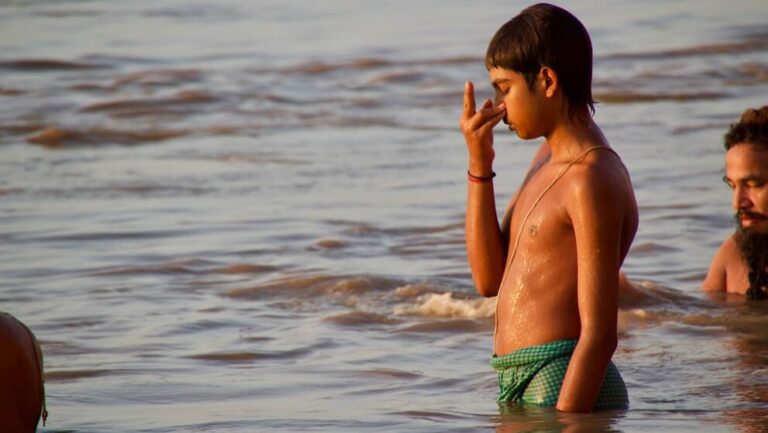The breath truly is the key in moving distractions from the mind.
(Read our introduction to the 8 limbs of yoga here…)
What is Pranayama?
Pranayama is the fourth limb of the eightfold path of yoga. Prana is the vital life force and energy that runs through our body. This beautiful energy is constantly flowing through us, and through all living beings. It can be used to describe the very essence that keeps us alive, as well as the energy in the universe around us. Prana also often describes the breath, and by working with the way we breathe, we affect the mind in a very real way.
Perhaps one of the most fascinating things about Pranayama is the fact that it can mean two totally different things, which may lead us in two totally different directions at this point on the path to freedom…
Pranayama can be understood as either ‘prana-yama’ which would mean ‘breath – control’ or ‘breath restraint’, or it could be understood as ‘prana-ayama’ which would translate as ‘freedom of breath’, ‘breath expansion’ or ‘breath liberation’.
Pranayama is the act of controlling and directing this energy, namely by controlling the flow of breath. Pranayama involves many different breathing techniques that aim at slightly different results in order to gain mastery over the respiratory process while recognizing the connection between the breath, the mind, and the emotions. As implied by the literal translation of pranayama, “life force extension,” yogis believe that it not only rejuvenates the body but actually extends life itself. My yoga teacher used to say that the quality of our breath determines the quality of our lives, and many yogis believed that the length of one’s life is determined by number of breaths, not by number of years. The deeper you breathe, the longer you can live.
We can use the breath to calm and balance ourselves, to energize the body and the mind, to cool or heat the body, but it always aims at promoting and maintaining our overall health. You can practice pranayama as an isolated technique (i.e., simply sitting and performing a number of breathing exercises), or integrate it into your daily hatha yoga routine. It’s not for nothing that the breath plays an important role in asana class. You begin the class by focusing on your breath, and everything kind of settles down. The day and its activities start seeming more distant, and all of a sudden there is no hurry anywhere anymore.
The Effects of Pranayama Practice
When we can control the breath, we can control the mind. If the mind is anxious, usually the breath tends to be shallow and fast, which in turn sends a signal to the nervous system that something is wrong.
By focusing and deliberately guiding and controlling the breath, we can send a signal to the nervous system that we are safe, everything is ok. This creates a place of peace and calm for the mind, the body relaxes and we receive space for concentration and meditation.
Physically, Pranayama is supporting the respiratory system by keeping it strong. We can also greatly influence the heart rate by controlling the breath. Long, steady breaths in and out for a period of time will slow down the heart rate and keep us in greater balance.
Pranayama goes together with asana practice and together they are considered to be the highest form of purification for the body and the mind.
How to Practice Pranayama in Your Daily Life?
When we start to practice Pranayama, it’s good to remember that we should never become breathless or anxious as we practice. Start slowly, and become aware of your breath in different situations in daily life.
If you are nervous or anxious, bring your awareness onto your breath and start to lengthen it. Make the exhale slightly longer than the inhale, and continue for few minutes. Observe the difference in the mind and the body.
As you are engaged in asana practice, you can keep your awareness in your breath. Try to keep the breath steady and long, and let the breath support you in the more challenging poses by making it deeper. When we bring more fresh air into the body, we bring more oxygen into the organs.
Study with your yoga teacher the different breathing techniques and explore their effects on you.
In its essence, Pranayama is easy to do in any place, any time. You can practice as you are sitting in a bus, or at your desk at work. Just a few minutes at a time, just a few controlled breaths at a time.
Breathing Techniques
The physical act of working with different breathing techniques alters the mind in a myriad of ways – we can choose calming practices like Chandra Bhadana (moon piercing breath) or more stimulating techniques such as Kapalabhati (shining skull cleansing breath).
Each way of breathing will change our state of being, but it’s up to us as to whether we perceive this as ‘controlling’ the way we feel or ‘freeing’ ourselves from the habitual way our mind may usually be.
These first four stages of Patanjali’s ashtanga yoga concentrate on refining our personalities, gaining mastery over the body, and developing an energetic awareness of ourselves, all of which prepares us for the second half of this journey, which deals with the senses, the mind, and attaining a higher state of consciousness.
Sources:
https://www.ekhartyoga.com/articles/the-8-limbs-of-yoga-explained
http://www.yogajournal.com/practice/the-eight-limbs
https://www.doyouyoga.com/pranayama-the-4th-limb-of-yoga-explained-40301/


1 comment